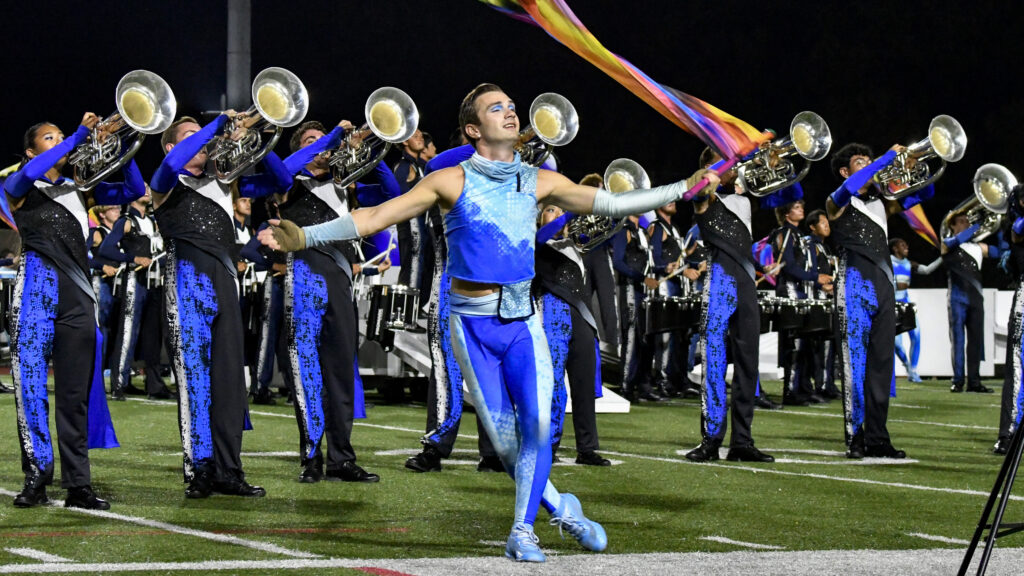
Sleep is in short supply this time of year. School is winding down, teachers are frantically trying to get through course material, and final projects and exams are descending on already-weary students. Most school kids dream of summer, when they can sleep till noon to make up for all those late school nights.^Drum corps kids, however, don’t have that option. Sleep is a funny thing on tour: oftentimes the one thing you need to function properly is the one thing you can’t seem to get, and due to overwhelming fatigue you find yourself falling asleep in what would, in normal life, seem the oddest of places, but which on tour are perfectly normal and acceptable.
Once honest-to-goodness tour (as opposed to everydays or spring training) starts, about half your sleep comes in the bus during travel, and the other half on the floor at the next housing site. Some corps use a formula in which an hour bus sleep counts as half an hour, and the corps is guaranteed eight hours, with the balance being made up in floor time. Some other corps are not so lucky — I remember days where we were only given an hour or two of floor time. Regardless of how long you spend there, the floor is far preferable to the bus when attempting to get some shut-eye.
Some of the advantages are obvious. In the bus you have to sleep sitting up; you’re squeezing into all sorts of positions nature never intended to be restful, and you wake up halfway through the bus ride with your calves screaming bloody murder for not having been stretched for the last three hours. And while you’re trying to find space for your legs, so is everyone else. If you sit next to the aisle, you have to figure out how to get comfortable against your seat partner; if you sit by the window, chances are your seat partner is using you for a pillow.
Each night a few lucky people can lay in the aisle to sleep on the bus.
This is a first-come-first-serve proposition that often involves as much contortion, to fit every interested party into the aisle.
While sleeping in the aisle was always, to me at least, a far more attractive option than sleeping in the seat, it has its own risks. At the least you’ll probably have the feet of the other people in the aisle right next to your head, and sharp turns always seem to bring someone’s bus box or water jug sliding into you. And, of course, everyone else has to climb over you to get out of the bus, a requirement that occasions much cursing and occasionally results in you getting stepped on. However, given the option between dozing sitting up and actually sleeping flat in the aisle, I’ll take the risks!
Of course, there are other difficulties to sleeping on the bus. It’s hard to maintain total darkness, especially with street lights, individual reading lights and the occasional video going. Of course there is always the chance of sonic disruption, especially on the drum bus! And the bus is often over-air conditioned so that you freeze, but without recourse to your warmer garments (at least without waking everyone else up). Just when you think you’ve come prepared in your flannel pants and sweatshirt, the air conditioning malfunctions and you end up stewing all night long. And you’re still sleeping, or trying to sleep, sitting up.
After attempting to sleep on the bus, getting to sleep on the floor seems like a night in a fine hotel. You get to stretch out, sleep flat, control your temperature, and block out the vast majority of light and noise. But despite these advantages, the floor is still … the floor. It’s hard, and there’s not a lot you can do to make it better. Some people use foam or camping pads under their sleeping bags. I’ve even seen a few do air mattresses — although who wants to have to inflate a mattress at three in the morning? Most of us, though, myself included, opt for just the sleeping bag.
Most gyms are pretty well outfitted for a standard drum corps: They’re air-conditioned, all the lights turn off, and there’s plenty of space for up to 135 or so sleepers. Occasionally, though, a school’s space isn’t proportioned quite right and you end up in a classroom with always-on safety lights, or the air conditioning in the school is turned off to save money in the summer. Or perhaps the gym is half taken up with bleachers or equipment, and the whole corps squeezes in together on the other side of the half-court line. It’s these unusual (although perhaps not as unusual as we would like!) situations that prove just how much our bodies will adapt because regardless of light, temperature, or lack of space, everyone seems to sleep one way or another.
Of course all this adaptability has its drawbacks: By the end of tour I’m so used to sleeping on a floor that once I get home, I can’t sleep in a bed anymore.
I think I’ll go take advantage of that bed while it lasts. Sweet dreams, everyone!





